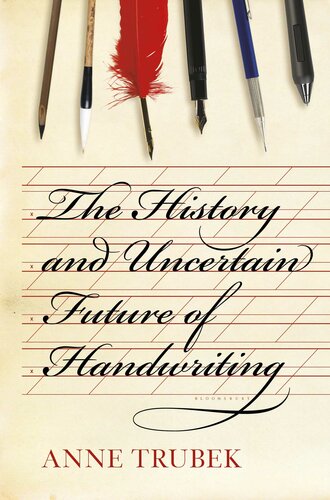
The History and Uncertain Future of Handwriting
کتاب های مرتبط
- اطلاعات
- نقد و بررسی
- دیدگاه کاربران
نقد و بررسی

May 23, 2016
What does the future hold for the oldest analog communication technology: writing by hand? Do we really need it? Trubek, publisher of Belt Magazine, explores these questions in a thoroughly enjoyable slim volume that begins with scratches on clay tablets and ends with National Handwriting Day, which is celebrated every January 23, the birthday of John Hancock, the man who signed his name so dramatically on the Declaration of Independence. Ancient Sumerian writing was limited to records and ceremony. Literacy became essential to a cultured person in ancient Greece with the invention of the modern alphabet, but not everyone welcomed it. Socrates believed that writing made men stupid by eliminating memory: “If you ask a piece of writing a question, it remains silent.” Trubek emphasizes that every revolution in written communication produces similar complaints: printed books were seen as fit only for the less educated, and now some believe that typing and email rob us of the individuality and intimacy of handwritten letters. Additionally she also explores the various ways handwriting has been linked to personal character. Trubek ends her delightful history with the conclusion that handwriting will not vanish but perhaps, like letterpress printing, become a fine art.

June 15, 2016
Beginning with hieroglyphs, cuneiform, and the invention of the alphabet, Trubek (A Skeptic's Guide to Writer's Houses) shows the impact of handwriting throughout history. Maintaining that handwriting is the latest form of the ongoing evolution of human communication, the author thoroughly discusses the various types of scripts, the contexts in which they have been used, and their role as prestige indicators. Also explored are employment opportunities in the field of handwriting, such as scribes, secretaries, and penmanship instructors. Trubek briefly profiles prominent figures in the profession, such as Platt Rogers Spencer and Austin Norman Palmer, while touching upon technological changes that have impacted the field (e.g., the printing press, typewriters). The advent of handwriting analysis as a modern-day discipline, including graphology, stylometrics, and forensic analysis is also investigated. Trubek concludes by asserting that current fears regarding the replacement of this practice by typing are misplaced. The only downside is that the short length of the volume disappointingly allows for only a cursory look at each topic. VERDICT An absorbing and concise book that will engage readers who are curious about communications.--Rebekah Kati, Durham, NC
Copyright 2016 Library Journal, LLC Used with permission.

June 1, 2016
A succinct overview of written communication.Belt magazine editor-in-chief Trubek (A Skeptic's Guide to Writers' Houses, 2010) turns from house museums of famous writers to the act of writing itself, tracing its history from cuneiform to digital messages. Observing a second-grader practicing penmanship in school, she remarks, "the prospect of not teaching students handwriting strikes many as unimaginable." However, notes the author optimistically, "new technologies do not kill off previous ones. Writing did not kill speech, but speaking took on new valences as writing came to compete with it." Readers may wonder at the idea that speaking is a technology and also at Trubek's easy acceptance of Socrates' notion that writing "caused humans to become less intelligent, less civilized, and less creative" and "decreases the human capacity to remember, to mentally retain and file facts, ideas, and experiences for later recall." She gives no supporting evidence for these assertions. Despite privileging orality, the Greeks invented the first alphabet to contain both consonants and vowels and wrote by running words together in unpunctuated paragraphs. The Romans created the letters we now use and invented books. Medieval scribes, usually from poor families, labored intensely to produce multiple copies of religious tracts. Gradually, secular scribes created books for schools and universities, traveling across Europe selling their services. Trubek discovered that handwriting varied dramatically from region to region, making it difficult for contemporary scholars to read manuscripts. The field of paleography emerged, with specialists trained to decipher different scripts. After the invention of the printing press, many former scribes became successful penmanship masters. In the 19th century, A.N. Palmer invented "an efficient, simple style" widely taught in schools. Typewriters' idiosyncratic letter arrangement was designed to prevent type bars from sticking together when struck sequentially. Although keyboarding competes with handwriting, Trubek believes that change offers opportunities "in accessibility, in democratization...that should be celebrated." Quirky facts enliven a brisk story of the history of handwriting.
COPYRIGHT(2016) Kirkus Reviews, ALL RIGHTS RESERVED.

























دیدگاه کاربران